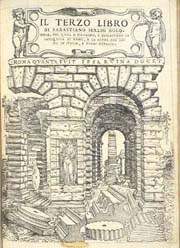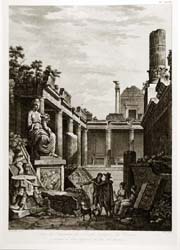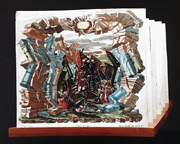Irresistible Decay
A site focusing on the special collections of the Research Library at the Getty Research Institute examining images of ruins as both symbols of decay and emblems of continuity over time
 |
|
The meaning of the word "ruin" has its origins in
the idea of fallen stones. When we frame an object as a ruin,
we reclaim it from a fall into decay and oblivion and
often for a form of cultural attention and care that elevates
the value of that object. The classical ruin has had a particular
status in the West: not only has it been rescued from oblivion,
it has been raised to an exalted position of contemplation and
reverence. All ruins are reclaimed because they are threatened
by the irresistible process of decay and the menacing forces
of forgetting. A ruin must remain exposed to these forces to
have its full effect on the beholder, but it must also be protected
from them if it is to survive. The decay of ruins is irresistible
because it reveals the passage of time as irresistible. Yet ruins
do resist because they persist, but not too well.
The first section of the resource, "Production and Framing" focuses on the process through which a decayed object is portrayed as a ruin. In other words, how an object or a place is transformed into a physical trace of the past that expresses its own process of decay.
The second section of the resource, "Recycling, Reconstruction, and Preservation", examines what one does with a ruin; how one treats it, cares for it, studies it. Ruins are often given particular status in a culture so that they might perform certain social, political, or aesthetic functions. At various times and places, they have been used to authenticate mythological origins, exemplify the achievements of past cultures, transmit moral lessons, and sustain and promote national identities. Ruins, however, can never belong fully to the present without losing their status as ruins.
The first section of the resource, "Production and Framing" focuses on the process through which a decayed object is portrayed as a ruin. In other words, how an object or a place is transformed into a physical trace of the past that expresses its own process of decay.
The second section of the resource, "Recycling, Reconstruction, and Preservation", examines what one does with a ruin; how one treats it, cares for it, studies it. Ruins are often given particular status in a culture so that they might perform certain social, political, or aesthetic functions. At various times and places, they have been used to authenticate mythological origins, exemplify the achievements of past cultures, transmit moral lessons, and sustain and promote national identities. Ruins, however, can never belong fully to the present without losing their status as ruins.
 |
|
The third section, "Loss, Recuperation, and Identity",
explores how ruins have come to stand for a lost or mythical
past. To whom does this past belong, and how is it reclaimed?
As Europeans explored various parts of the world, they took established
conventions of "framing" and representation with them.
Were the investigations of archaeologists, photographers, and
historians an ethnocentric attempt to colonize the past of others,
or were they a more universal, humanist effort to understand
how Western civilization was related to others around the world?
Perhaps these two impulses were closely entwined.
Like the Lisbon earthquake of the eighteenth century and the bloody conflicts of the nineteenth, the total wars of the twentieth century have shaken our concept of ruins. In the wake of World War II, culture itself has come to be cast as a ruin: it is more a troubled witness to the violence of humanity than a spectator of the sublime powers of nature. In the twentieth century, the regular rhythms of the natural world have been overshadowed by the enormity of our capacity for ruination. Understanding why ruins are reclaimed—understanding the irresistible attractions of their decay—requires an acknowledgment of the diversity of their cultural significance. The transformation of ruins from collapsed, forgotten buildings into monuments of cultural, political, and historical function has occurred as the understanding of their form and meaning has evolved. These changes can be traced through artists' representations of ruins, from early woodcut emblems to technically proficient architectural drawings, allegorical frontispieces, utopian landscapes, and documentary photographs.
Like the Lisbon earthquake of the eighteenth century and the bloody conflicts of the nineteenth, the total wars of the twentieth century have shaken our concept of ruins. In the wake of World War II, culture itself has come to be cast as a ruin: it is more a troubled witness to the violence of humanity than a spectator of the sublime powers of nature. In the twentieth century, the regular rhythms of the natural world have been overshadowed by the enormity of our capacity for ruination. Understanding why ruins are reclaimed—understanding the irresistible attractions of their decay—requires an acknowledgment of the diversity of their cultural significance. The transformation of ruins from collapsed, forgotten buildings into monuments of cultural, political, and historical function has occurred as the understanding of their form and meaning has evolved. These changes can be traced through artists' representations of ruins, from early woodcut emblems to technically proficient architectural drawings, allegorical frontispieces, utopian landscapes, and documentary photographs.
The illustrated rare books, artists' drawings, and vintage photography on display in this resource are part of the Special Collections of the Getty Research Institute. These collections of original sources have been assembled to stimulate interdisciplinary investigations of the past and the past's significance in the present and for the future. The largest body of research material on the representation of ruins consists of photographs numbering in the tens of thousands, which document antiquities around the world. Taken over the past 150 years, these images portray monuments that have been objects of study and contemplation for centuries. Archaeological views and cityscapes show
changes wrought by time, including the marks of natural deterioration, disaster,
war, urban development, tourism, and looting. The photograph, however, is
not merely an objective instrument; it is also used to communicate and decipher
very subjective points of view.
 |
|
Illustrated books of the sixteenth through the nineteenth centuries
are a second considerable source of imagery. They depict the
state of architectural remains in the age before the photographic
lens and, more important, the ways in which they were assimilated
into visual vocabularies. Although fragments of buildings and
sculptures are familiar images in the iconography of Western
art, the presence of decay implies a particular aesthetic sensibility,
one that is imbued with a sense of mortality, melancholy, and
nostalgia. Among these books are writings by antiquarians and
architects who were interested not only in the particular expressions
of building design and decoration but also in the links between
the physical traces of earlier civilizations and mythology, secular
literature, and sacred texts. The holdings of architectural treatises
and guidebooks to major European cities, catalogs of archaeological
artifacts, and travel descriptions are strong points of the Getty
Research Institute collections.
Original works created by artists and architects register the landscapes or objects from which they drew inspiration and present a record of their draughtsmanship. The examples shown span the period from the eighteenth century, when artists on the Grand Tour took the opportunity to travel and draw from first-hand observation, to the present. Contemporary artists have approached the theme of the ruin in terms of remembering—and of liberation from—the traditional values of the past.
The visual resources on the theme of ruins that are included in Irresistible Decay: Ruins Reclaimed illustrate how a consciousness of history emerges from the many subjective responses to its remains. As you look at the images of "Irresistible Decay" consider what legacies of the past survive in the present world and what values they may hold for the future.
Original works created by artists and architects register the landscapes or objects from which they drew inspiration and present a record of their draughtsmanship. The examples shown span the period from the eighteenth century, when artists on the Grand Tour took the opportunity to travel and draw from first-hand observation, to the present. Contemporary artists have approached the theme of the ruin in terms of remembering—and of liberation from—the traditional values of the past.
The visual resources on the theme of ruins that are included in Irresistible Decay: Ruins Reclaimed illustrate how a consciousness of history emerges from the many subjective responses to its remains. As you look at the images of "Irresistible Decay" consider what legacies of the past survive in the present world and what values they may hold for the future.
Claire Lyons, former Collections Curator for the History of Archaeology and Ancient Art, Research Library, The Getty Research Institute
Michael Roth, (former) Associate Director, The Getty Research Institute
Charles Merewether, (former) Collections Curator, Research Library, The Getty Research Institute
Michael Roth, (former) Associate Director, The Getty Research Institute
Charles Merewether, (former) Collections Curator, Research Library, The Getty Research Institute